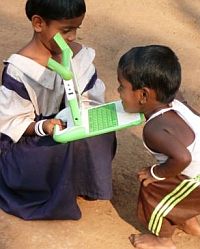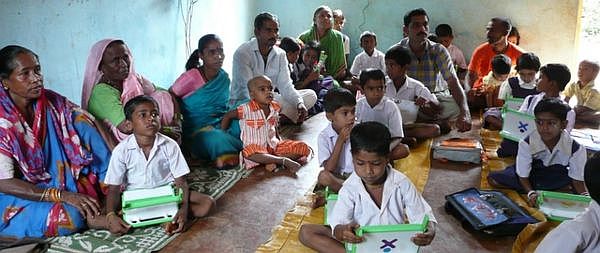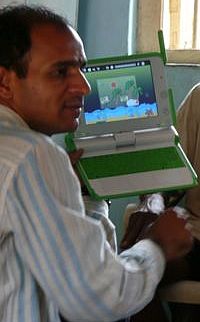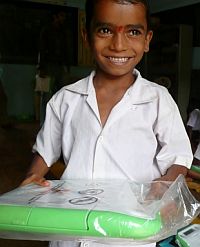The OLPC India pilot has its first write-up by Carla Gomez Monroy and besides being the longest report from her to date, its also one of the most comprehensive. She has detailed multiple aspects of the One Laptop Per Child implementation in the Khairat-Dhangarwada village school, Raigadh district, Maharashtra state, India.
Unlike OLPC Nigeria, where the poor children of Galadima school are juxtaposed with the wealthy Abuja Model City, Khairat is far off any major road and can only be reached by a footpath. In fact, the history of school itself displays the overwhelming obstacles to providing primary education in rural India:
Khairat school is a one-room schoolhouse. The land to build it was donated by a villager, who is extremely happy with the idea of having the children of the town educated. I was told that she used to go and help the construction workers with the building of the school.Note that the school is a community, not government, supported resource. This situation is not unique to India or to the developing world, and one of the major obstacles to a government supported OLPC implementation. How can XO's be passed out like schoolbooks when many governments don't even sponsor local schools, much less distribute textbooks to them?She also came to help organize the digging of the hole for grounding the server. The building itself was sponsored by a villager who has a lot of land in the area. He also supports, on a continual basis, with other items the school needs.
But once in a school, Carla shows how much promise low-cost laptops designed for education offer, no matter their level of localization:
Even when English and Marathi are so different, even when the keyboard is in English, even when the interface is in English, even when we don't speak each other's language, and even when they are so new to computers, the XO is so user-friendly that I can manage to get across to them, to show them how to do something with it. And in little time, and having lots of fun, the children of a completely different language are doing this or that on their XOs.By the way, there is a major effort underway to provide XO localization for India so children can learn in their local languages, and English. If you can help, get involved today.
The Khairat school headmaster is certainly involved, even learning Project-based learning from Carla. Check out how he integrated the multidisciplinary idea of projects with the multiple subject areas in his curricula with one seemingly simple topic: trees:
- What's a tree? Its parts, kinds, the ones that children have at home, the fruits and products that come from trees, the different kinds for different uses (furniture, curative uses, food,...) Why trees are good for us and for the world. How they grow. Pollination. Photosynthesis. How to take care of them. Why and how to take care of them. Water cycle
- Experiments with growing flowers of different colors or taking care of a small plant, to understand the CO2 cycle
- Kinds of trees depend on the ecosystem, by area, by temperature,....
- Children can count kinds of trees, or number of trees in town. And do different problem sets related with trees.
- Newton's law of gravity came from an apple that fell from a tree, to get into physics
- Mahatma Gandhi's analogy of religion being like a tree.
- Deforestation, ozone layer,
- Regulations and legislations of the government about trees,
- Government, NGO's and other initiatives doing something about trees
- and many more
Carla reports that the initial cell phone based Internet connection was too slow for the 22 inquiring minds and there was an effort to connect the school to high-speed Internet. Apparently, thanks to Reliance Anil Dhirubhai Ambani Group (R-ADAG) there is now a faster connection, but I wonder about the infrastructure required to support it.
As we learned from OLPC Nigeria's shocking electrical power costs, the total cost of ownership for technology support systems can often be greater than the initial cost of the equipment.
Carla also gives us a glimpse into one rarely mentioned aspect of rural education. Some children simply don't like school, and not even an XO laptop can entice them to "learn learning" away from home. Hopefully, Garima (not her real name - all children's names in the story are fictional) will at least be inspired to self-educate once her siblings start to share and explore on their XO's.
If so, that will be a major achievement for One Laptop Per Child in India and worldwide.






If your school district needs an animal to power the generator, then maybe your school isn't ready for a computer lab. Spend the money on something that won't pile up in a land fill when they won't update.
I remember a trip to Southern Mexico. I met a nine year old boy there who was learning English and other things from the "L" volume of an old American encyclopedia. I don't think he would have been impared any by having the latest Wikipedia instead. You and I both know this project probably isn't about children or charity. Having a good school in town makes everybody's estate more valuable. Having a worldwide billion+ literate youth in about 10 years makes world labor productivity soar. Thinking of a better way to allocate educational money isn't the point. However, I would agree with you on something you have implied but not stated. I do hope the first people getting these laptops are the teachers and forward looking education officials. They need to have their own thinking shaken and a little time to plan.
For more photos of the India pilot, check out this Flickr pool: http://www.flickr.com/photos/venky7/sets/72157603606772250/